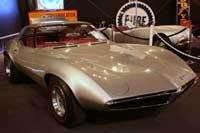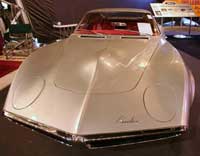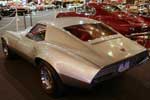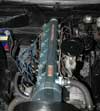A vehicle design that challenged the limits of American engineering and thinking. John DeLorean’s vision for a Pontiac 2-seat sports car, with long sweeping hood and short rear deck styling.

This all original Grey hardtop, with Red interior, and Pontiac Overhead Cam six cylinder engine weighed in at only 2200 pounds and utilized a unique solid-body construction of exterior fiberglass and steel under body. The Banshee had all the elements of an awesome performer. General Motors executives viewed the concept to be too much of a threat to the Corvette and as a result additional development. Only two runnable prototypes were built. The car’s instructed DeLorean to cease influence on future GM products spanned decades.
During its development in 1964 it was called the XP-833 project. This car was a small two-seater with a long, sweeping hood and a short rear deck. Several different versions were constructed, but only two drivable prototypes were ever built. One was a silver hard-top with a straight six engine and the other is a white convertible with a V-8. Both survive today and are in the hands of private collectors.

The styling on these cars is highly reminiscent of what appeared on third- generation Corvettes in 1968. Another styling cue that made production was the design of the tail lights, which are nearly identical to that found on second- generation Pontiac Firebirds. Indeed, the high performance and sensuous styling of the Banshee may have led to its demise. Head of Pontiac John DeLorean called this car the “Mustang Fighter” and rumor has it he fully intended to bring it to production. However, his bosses at GM felt that it would be a threat to the Chevrolet Corvette in that it would steal sales from the Corvette and also that (if DeLorean had his way) it could out-perform the Corvette as well.
This did not sit well with GM execs who had marketed the Corvette as their top performer; even today, recent models such as the Camaro and Firebird – even though using the same engine as Corvette – have those engines de-tuned slightly so they will not have as high a horsepower rating as a Corvette. The Banshee would have had equivalent horsepower, yet weighed 500 lb (227 kg) less than the Corvette and so would have been a potent package. It was able to reach 60 mph (97 km/h) in second gear. GM executives instructed DeLorean to cease further development in 1966.
Banshee II
Made in 1968, the Banshee II was the second in the Banshee
series.
The 1968 Pontiac Banshee II had aerodynamic fiberglass skins over stock Firebird inner panels and a near stock black interior.
In 1969, the Banshee II was modified with white paint and graphics, including a chicken decal on the nose. It was then re-christened the Firebird Fiero.
It had flush wheel covers, a deep louvered hood, cut down glass, brake cooling vents, minimal ground clearance, and separate headrests for passenger and driver. It was powered by a 400 C.I.D. V8 engine.
Banshee III
Made in 1974, the Banshee III was the third in the Banshee
series. The front end bears some similarities to the later Trans-Ams.
The
1974 Pontiac Banshee III was developed from a Pontiac Firebird platform with a
long sloping front end and more aerodynamic rear styling. The front was a
smooth blend of bumper sheet metal and covered headlamps for improved
aerodynamics. The soft face bumper system consisted of body color urethane over
an energy absorbing foam base, and the quartz halogen rectangular headlamps had
a three-beam system, low, freeway and high.
Side glass was fixed and flush to sheet metal for improved aerodynamics and reduced wind noise, and an electrically operated access panel or toll window, was provided in the fixed side glass design.
The interior had red leather upholstery. The rear seat folded for additional luggage space and the seat harness system was anchored in the structural seat. A 455 CID Super Duty V8 Pontiac engine powered it.
The metallic maroon Banshee III made its public debut in 1974. It had four slit style taillights, but these became twenty “high-tech, round-hole” taillights when it was updated in 1976.
Banshee IV
Known within GM as the “Banshee IV”, this car was unveiled
in 1988 the two-door, four-seat Banshee IV had a sleek and sensuous futuristic
design. Its fiberglass body was painted bright red, while its triangular hood
was matte black. A 230 horsepower fuel-injected, single overhead cam V8 engine
powered the rear wheels. A heads-up display system (HUD) projected information
about speed, engine RPM, and fuel level on the windshield in the driver’s field
of vision. The dashboard featured video displays and numerous buttons; the
steering wheel alone contained about twenty. The dual rear wings were also
adjustable. Like its predecessors, it was intended to establish exterior and
interior design themes that would be modified for production versions of the
Pontiac Firebird and Pontiac Trans Am sports cars. The Banshee IV successfully
influenced the overall appearance for the fourth generation of those cars.



